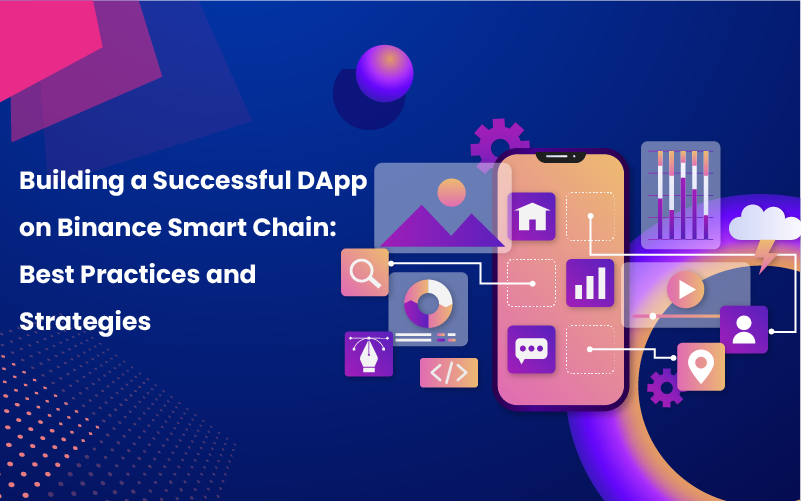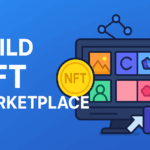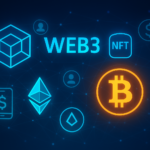Are you an aspiring blockchain developer looking to build a successful decentralized application (DApp) on Binance Smart Chain? Look no further! In this article, we will dive into the best practices and strategies that will set you up for success. Building a DApp can be a daunting task, but with the right approach, you can create a thriving application that attracts users and drives engagement. We will explore the key elements to consider, such as smart contract development, user experience design, and effective marketing strategies.
Additionally, we will discuss the importance of security and scalability in ensuring the longevity of your DApp. Whether you are a seasoned developer or just starting your journey in the world of blockchain, this article will provide you with valuable insights and practical tips to help you build a successful DApp on Binance Smart Chain. So, let’s get started and unlock the potential of this exciting technology!
Benefits of building a DApp on Binance Smart Chain
Building a DApp on Binance Smart Chain offers numerous benefits that make it an attractive choice for developers. One of the key advantages is the low transaction fees compared to other blockchain platforms. Binance Smart Chain operates on a Proof of Stake mechanism, allowing for faster and more cost-effective transactions. This makes it easier for users to interact with your DApp without worrying about high fees, resulting in increased adoption and usage.
Another benefit of Binance Smart Chain is its compatibility with the Ethereum Virtual Machine (EVM), which means that developers can easily port their existing Ethereum DApps to the Binance Smart Chain ecosystem. This compatibility enables developers to tap into the existing Ethereum user base while taking advantage of the lower fees and faster transaction speeds offered by Binance Smart Chain.
Furthermore, Binance Smart Chain provides a vibrant and growing ecosystem with a wide range of decentralized finance (DeFi) protocols and applications. This ecosystem offers opportunities for collaboration, integration, and cross-promotion, allowing your DApp to leverage the existing user base and gain visibility within the Binance Smart Chain community.
Key considerations before building a DApp on Binance Smart Chain
Before diving into the development process, it is important to consider a few key factors that can contribute to the success of your DApp on Binance Smart Chain. Firstly, it is crucial to identify and understand your target audience. Analyze their needs, preferences, and pain points to tailor your DApp accordingly. Conduct market research and competitor analysis to identify gaps and opportunities within the Binance Smart Chain ecosystem.
Secondly, ensure that your DApp solves a genuine problem or provides a unique value proposition. With the increasing number of DApps, it is essential to differentiate your application from the competition. Identify the pain points of your target audience and design your DApp to address these issues effectively. This will not only attract users but also increase user retention and engagement.
Lastly, consider the scalability of your DApp. Binance Smart Chain provides a high throughput capacity, but it is still important to optimize your smart contracts and application architecture to ensure efficient performance even during peak usage. Scalability is crucial to accommodate the growing user base and maintain a seamless user experience.
Understanding the Binance Smart Chain ecosystem
To build a successful DApp on Binance Smart Chain, it is essential to have a solid understanding of the ecosystem. Binance Smart Chain operates with a dual-chain architecture, consisting of the Binance Chain and the Binance Smart Chain. The Binance Chain is responsible for handling the native BNB cryptocurrency, while the Binance Smart Chain focuses on smart contract functionality.
The Binance Smart Chain ecosystem offers a wide range of tools and resources that can facilitate the development process. These include development frameworks, software development kits (SDKs), and development environments. Familiarize yourself with these resources to streamline your development workflow and ensure efficient development and deployment of your DApp.
Additionally, explore the existing DApps and protocols within the Binance Smart Chain ecosystem. This will give you insights into the types of applications that are successful and popular among users. Understanding the existing landscape can help you identify gaps and opportunities for your own DApp.
Choosing the right technology stack for your DApp
Choosing the right technology stack is crucial for the successful development of your DApp. Consider the following factors when selecting the technology stack for your DApp on Binance Smart Chain.
Firstly, evaluate the programming languages and frameworks that are supported by Binance Smart Chain. Solidity, the programming language used for Ethereum smart contracts, is also compatible with Binance Smart Chain. This allows for easy porting of Ethereum-based DApps to Binance Smart Chain. Additionally, consider using web development frameworks such as React or Angular for the frontend development of your DApp.
Secondly, ensure that the technology stack you choose provides the necessary security features. Security is of paramount importance in the blockchain space, and your DApp should be designed with security in mind. Consider using audited and battle-tested smart contract libraries and frameworks to minimize the risk of vulnerabilities.
Lastly, consider the scalability and performance of the technology stack. Binance Smart Chain offers high throughput, but it is important to select a technology stack that can handle the expected user load and transaction volume. Optimize your smart contracts and application architecture to ensure efficient performance and scalability.
Smart contract development best practices
Smart contracts are the backbone of any DApp on Binance Smart Chain. Follow these best practices to ensure the robustness and security of your smart contracts.
Firstly, thoroughly test your smart contracts before deployment. Use testnets to simulate real-world scenarios and identify any potential vulnerabilities or bugs. Conduct extensive unit testing and stress testing to ensure that your smart contracts behave as intended and can handle various edge cases.
Secondly, follow secure coding practices to minimize the risk of vulnerabilities. Avoid using deprecated functions or features, as they may have known security flaws. Implement access controls and permission levels to ensure that only authorized users can interact with your smart contracts.
Additionally, consider implementing upgradeability mechanisms. Smart contracts on Binance Smart Chain can be upgraded, allowing you to fix bugs or add new features without disrupting the entire DApp. However, ensure that the upgradeability mechanism does not compromise the security or integrity of the smart contracts.
User interface and user experience design for DApps
The user interface (UI) and user experience (UX) design of your DApp play a crucial role in attracting and retaining users. Follow these design principles to create an intuitive and engaging user experience.
Firstly, prioritize simplicity and ease of use. Users should be able to navigate and interact with your DApp without facing any barriers or confusion. Minimize the number of steps required to complete a task and design clear and intuitive user flows.
Secondly, ensure that your DApp is responsive and compatible with different devices and screen sizes. Mobile compatibility is particularly important, as a significant portion of users access DApps through mobile devices. Test your DApp on different devices and screen sizes to ensure a consistent and seamless user experience.
Additionally, consider incorporating gamification elements to increase user engagement. Rewards, achievements, and leaderboards can incentivize users to actively participate in your DApp and increase user retention.
Testing and deploying your DApp on Binance Smart Chain
Thorough testing and efficient deployment are essential to ensure the smooth operation of your DApp on Binance Smart Chain. Follow these steps to test and deploy your DApp effectively.
Firstly, conduct comprehensive testing on testnets to identify and fix any issues or vulnerabilities. Testnets provide a safe environment to simulate real-world scenarios and ensure that your DApp functions as intended. Perform unit testing, integration testing, and stress testing to validate the functionality and performance of your DApp.
Once your DApp has been thoroughly tested, it is time to deploy it on the Binance Smart Chain mainnet. Follow the deployment guidelines provided by Binance Smart Chain to ensure a smooth deployment process. Consider using deployment tools and frameworks to automate and streamline the deployment process.
After deployment, monitor the performance and user feedback of your DApp. Continuously iterate and improve your DApp based on user feedback and market demands. Regular updates and feature enhancements can help maintain user engagement and attract new users.
Marketing and promoting your DApp
Effective marketing and promotion are crucial to the success of your DApp on Binance Smart Chain. Follow these strategies to increase visibility and attract users to your DApp.
Firstly, create a compelling and informative website for your DApp. The website should clearly communicate the value proposition of your DApp and provide relevant information for potential users. Optimize your website for search engines to increase organic traffic.
Secondly, leverage social media platforms and online communities to promote your DApp. Engage with the Binance Smart Chain community and participate in relevant discussions to increase visibility. Create engaging content, such as blog posts, videos, and infographics, to attract and educate potential users.
Additionally, consider partnering with other DApps or DeFi protocols within the Binance Smart Chain ecosystem. Collaborative marketing efforts can help cross-promote your DApp and tap into the existing user base of partner projects.
Security and risk management for DApps on Binance Smart Chain
Security is of paramount importance when building a DApp on Binance Smart Chain. Follow these security best practices to protect your DApp and user funds.
Firstly, conduct thorough security audits of your smart contracts. Engage with reputable third-party auditing firms to identify and address any potential vulnerabilities or weaknesses in your smart contracts. Regularly update and patch your smart contracts to mitigate newly discovered security risks.
Secondly, implement multi-factor authentication and secure key management practices. Protect user funds by requiring multiple layers of authentication and storing private keys in secure hardware wallets or cold storage.
Additionally, educate your users about common security risks and best practices. Provide clear instructions on how to securely interact with your DApp and avoid common scams or phishing attempts. Regularly communicate with your users about security updates and precautions.
Case studies of successful DApps on Binance Smart Chain
To further illustrate the potential of building a successful DApp on Binance Smart Chain, let’s take a look at a couple of case studies.
Case Study 1: PancakeSwap
PancakeSwap is a decentralized exchange (DEX) and automated market maker (AMM) built on Binance Smart Chain. It offers fast and low-cost transactions, making it a popular choice for users looking to trade cryptocurrencies. PancakeSwap gained popularity due to its user-friendly interface, extensive range of supported tokens, and innovative features such as yield farming and staking.
Case Study 2: Venus
Venus is a decentralized lending and borrowing protocol built on Binance Smart Chain. It allows users to earn interest on their cryptocurrency holdings or borrow assets by collateralizing their existing holdings. Venus gained traction due to its competitive interest rates, low transaction fees, and seamless integration with other DeFi protocols within the Binance Smart Chain ecosystem.
These case studies highlight the potential for success when building a DApp on Binance Smart Chain. By understanding the needs of users and leveraging the unique features and benefits of Binance Smart Chain, you can create a DApp that attracts users and drives engagement.
Conclusion and key takeaways
Building a successful DApp on Cryptoexchange4u Binance Smart Chain requires careful planning, strategic thinking, and a deep understanding of the ecosystem. By following the best practices and strategies outlined in this article, you can set yourself up for success and create a thriving application that attracts users and drives engagement.
Key takeaways from this article include the benefits of building a DApp on Binance Smart Chain, the key considerations before embarking on the development process, understanding the Binance Smart Chain ecosystem, choosing the right technology stack, smart contract development best practices, designing a user-friendly interface and user experience, testing and deploying your DApp effectively, marketing and promoting your DApp, ensuring security and risk management, and learning from successful case studies.
Now that you have the knowledge and insights, it’s time to start building your own successful DApp on Binance Smart Chain. Unlock the potential of this exciting technology and embrace the opportunities it offers. Happy building!






















0 Comments